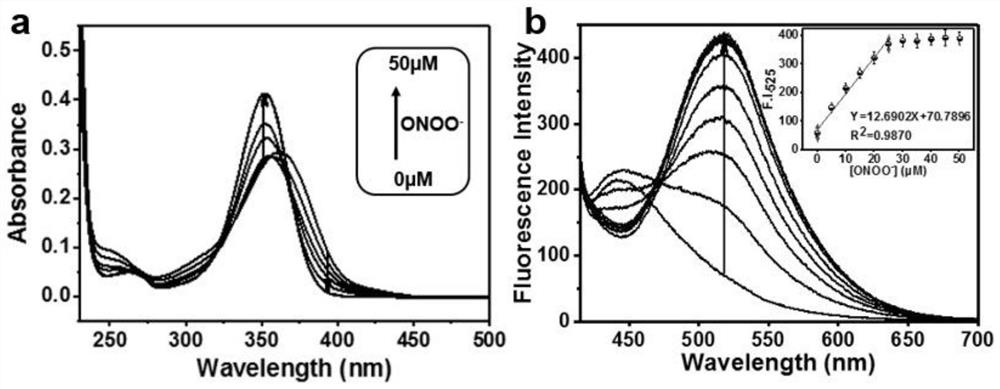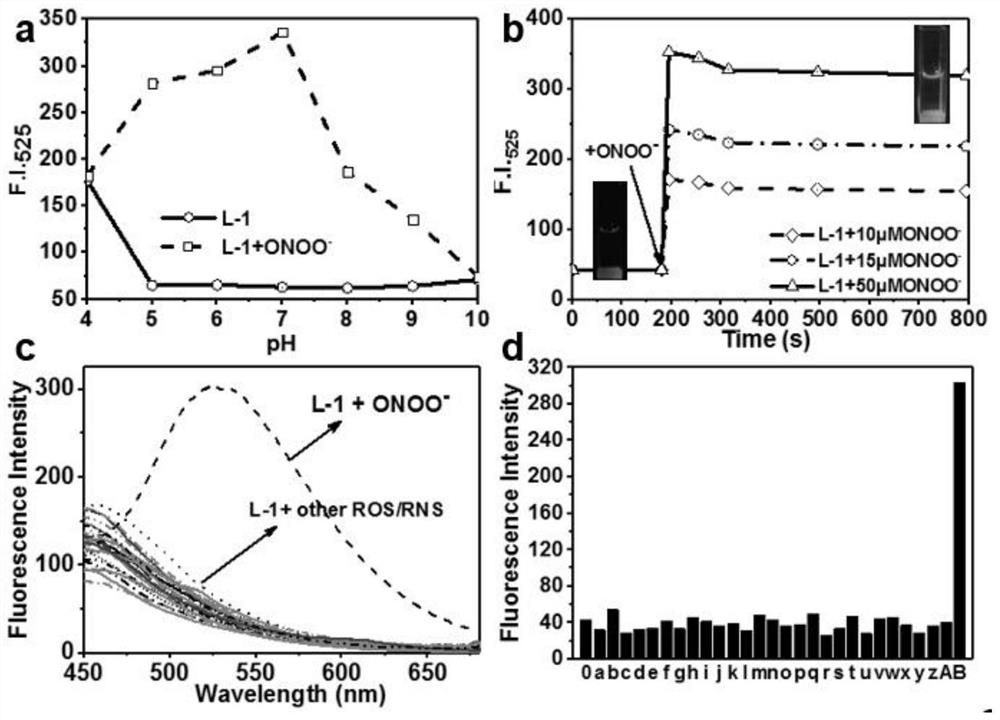ONOO<-> fluorescent probe as well as preparation method and application thereof
A fluorescent probe and reaction technology, applied in the field of fluorescent probes, can solve problems such as inability to realize large-scale synthesis, poor selectivity, complex chemical structure, etc., and achieve good promotion and application value, obvious colorimetric changes, and high sensitivity effects
- Summary
- Abstract
- Description
- Claims
- Application Information
AI Technical Summary
Problems solved by technology
Method used
Image
Examples
Embodiment 1
[0038] 1. ONOO - Preparation of fluorescent probe L-1
[0039] 4-(N,N-diethylamino) salicylaldehyde (0.193g, 1mmol) and 2-hydrazinopyridine (0.109g, 1mmol) were stirred and reacted at 40°C for 24h in absolute ethanol (20ml) to form a precipitate. After filtering and washing with absolute ethanol (10ml*3), the product was dried to obtain a light yellow solid with a yield of 55%.
[0040] Prepared ONOO - Fluorescent probes were characterized as follows: 1 H NMR (300MHz, CDCl 3 ):δ=10.73(s,1H),8.13(d,J=5.1Hz,1H),7.88(s,1H),7.71–7.60(m,1H),7.11–6.97(m,2H), 6.79( dd,J=6.7,5.5Hz,1H),6.27(dq,J=4.9,2.5Hz,2H),3.41(q,J=7.1Hz,4H), 2.16(s,2H),1.22(t,J =7.1Hz,6H). 13 C NMR (75MHz, CDCl 3 ):δ=159.19,155.91, 149.98,147.17,144.67,138.60,131.24,115.34,106.91,106.62,103.75,98.27,44.47,12.66.LC-MS:m / z[M+H] + calcd for [C 16 h 20 N 4 O+H] + :285.1710, found 285.1594.
[0041] Prepare the ONOO - The reaction equation of the fluorescent probe is:
[0042]
[0043] 2. Preparation o...
Embodiment 2
[0052] The research of embodiment 2 ultraviolet absorption and fluorescence spectrum
[0053] Monitoring the response of fluorescent probe L-1 to various concentrations of ONOO by titration experiments - (0-50μM) analytical capability. in the absorption spectrum figure 1 a, with ONOO - The concentration of the fluorescent probe L-1 increased from 0 μM to 50 μM, and the main absorption peak of the fluorescent probe L-1 showed a blue shift, moving from 360nm to 350nm; at the same time figure 1 b, The weak fluorescence emission of the free probe at about 450 nm weakens, a new emission band appears at 525 nm, and the fluorescence intensity increases accordingly. With ONOO - Concentrations increase from 0 to 25 μM ONOO - Within the concentration range, the fluorescence intensity (525nm) and ONOO - There is an excellent linear relationship between concentrations (R 2 = 0.9870). When ONOO in solution - When the concentration is greater than 25μM, the fluorescence intensity t...
Embodiment 3
[0054] The influence of embodiment 3pH and reaction time on the response of fluorescent probe L-1
[0055] The fluorescent probe L-1 itself does not change significantly in a wide range (pH=5-10), which indicates that the pH value has almost no effect on the fluorescence emission of L-1. When fluorescent probe L-1 and ONOO - In response, L-1 to ONOO - After the response, the fluorescence intensity reached the maximum at pH = 7, which indicated that the probe L-1 was neutral to ONOO - Fluorescence changes in response are most pronounced. In order to simulate the detection environment in vivo, physiological pH (pH=7.4) was selected as the working pH in the following experiments. Afterwards, the response time, as an important factor to evaluate the actual sensing performance of the probe, was also investigated. Such as figure 2 As shown in a, without ONOO - In the case of , almost no change in the fluorescence of probe L-1 was observed. Such as figure 2 b, when applying...
PUM
 Login to View More
Login to View More Abstract
Description
Claims
Application Information
 Login to View More
Login to View More - R&D
- Intellectual Property
- Life Sciences
- Materials
- Tech Scout
- Unparalleled Data Quality
- Higher Quality Content
- 60% Fewer Hallucinations
Browse by: Latest US Patents, China's latest patents, Technical Efficacy Thesaurus, Application Domain, Technology Topic, Popular Technical Reports.
© 2025 PatSnap. All rights reserved.Legal|Privacy policy|Modern Slavery Act Transparency Statement|Sitemap|About US| Contact US: help@patsnap.com



